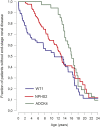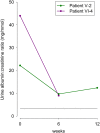ADCK4-Associated Glomerulopathy Causes Adolescence-Onset FSGS
- PMID: 25967120
- PMCID: PMC4696579
- DOI: 10.1681/ASN.2014121240
ADCK4-Associated Glomerulopathy Causes Adolescence-Onset FSGS
Abstract
Hereditary defects of coenzyme Q10 biosynthesis cause steroid-resistant nephrotic syndrome (SRNS) as part of multiorgan involvement but may also contribute to isolated SRNS. Here, we report 26 patients from 12 families with recessive mutations in ADCK4. Mutation detection rate was 1.9% among 534 consecutively screened cases. Patients with ADCK4 mutations showed a largely renal-limited phenotype, with three subjects exhibiting occasional seizures, one subject exhibiting mild mental retardation, and one subject exhibiting retinitis pigmentosa. ADCK4 nephropathy presented during adolescence (median age, 14.1 years) with nephrotic-range proteinuria in 44% of patients and advanced CKD in 46% of patients at time of diagnosis. Renal biopsy specimens uniformly showed FSGS. Whereas 47% and 36% of patients with mutations in WT1 and NPHS2, respectively, progressed to ESRD before 10 years of age, ESRD occurred almost exclusively in the second decade of life in ADCK4 nephropathy. However, CKD progressed much faster during adolescence in ADCK4 than in WT1 and NPHS2 nephropathy, resulting in similar cumulative ESRD rates (>85% for each disorder) in the third decade of life. In conclusion, ADCK4-related glomerulopathy is an important novel differential diagnosis in adolescents with SRNS/FSGS and/or CKD of unknown origin.
Keywords: familial nephropathy; focal segmental glomerulosclerosis; genetic renal disease; glomerulopathy; mitochondria.
Copyright © 2016 by the American Society of Nephrology.
Figures


References
-
- Chinnery PF: Mitochondrial Disorders Overview. In: GeneReviews®, edited by Pagon RA, Adam MP, Ardinger HH, et al, Seattle, WA, University of Washington, Seattle, pp 1993–2015, [Internet], Available from http://www.ncbi.nlm.nih.gov/books/NBK1224/ - PubMed
-
- Guéry B, Choukroun G, Noël LH, Clavel P, Rötig A, Lebon S, Rustin P, Bellané-Chantelot C, Mougenot B, Grünfeld JP, Chauveau D: The spectrum of systemic involvement in adults presenting with renal lesion and mitochondrial tRNA(Leu) gene mutation. J Am Soc Nephrol 14: 2099–2108, 2003 - PubMed
-
- Ozaltin F: Primary coenzyme Q10 (CoQ 10) deficiencies and related nephropathies. Pediatr Nephrol 29: 961–969, 2014 - PubMed
Publication types
MeSH terms
Substances
LinkOut - more resources
Full Text Sources
Medical
Molecular Biology Databases

